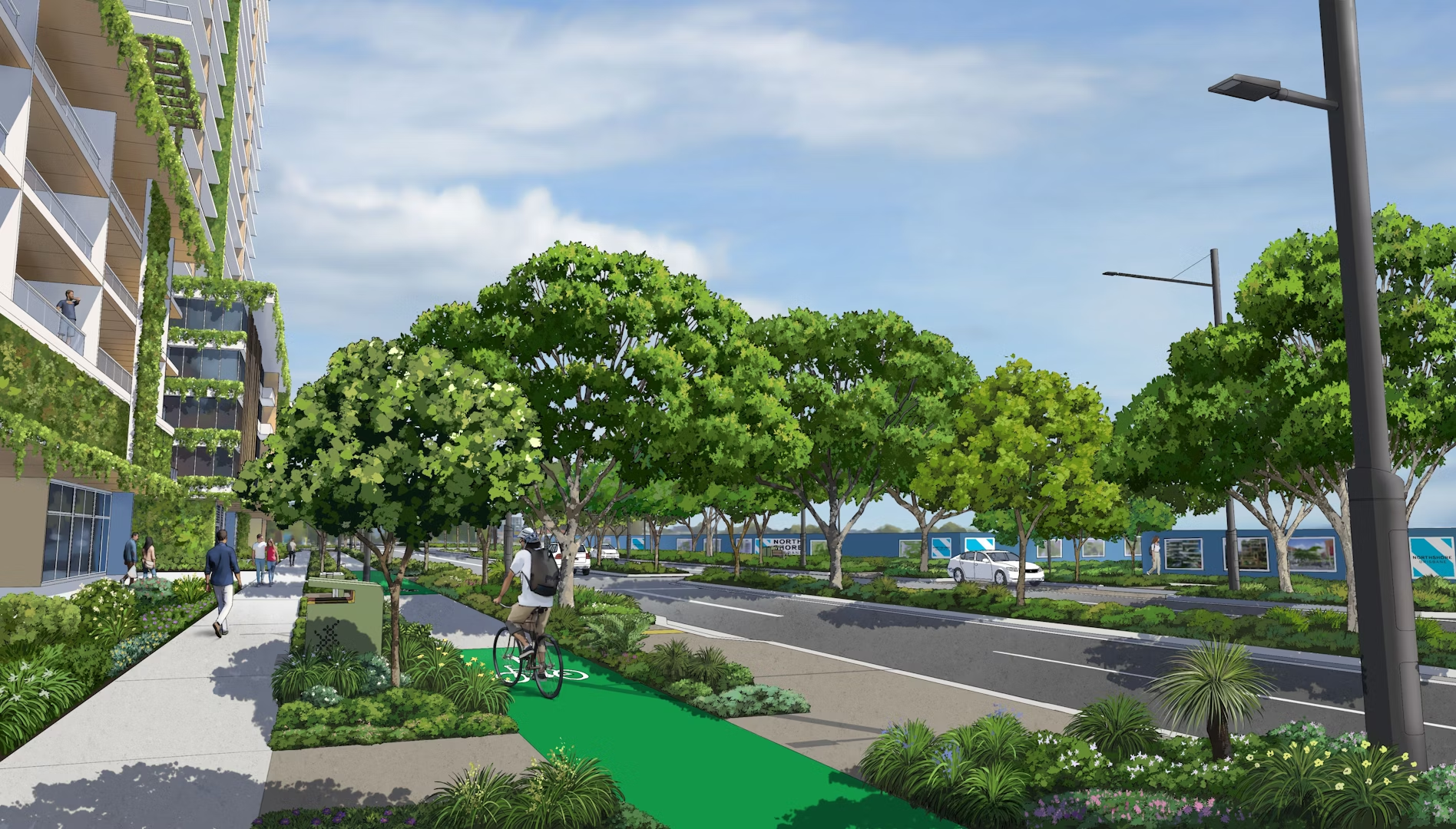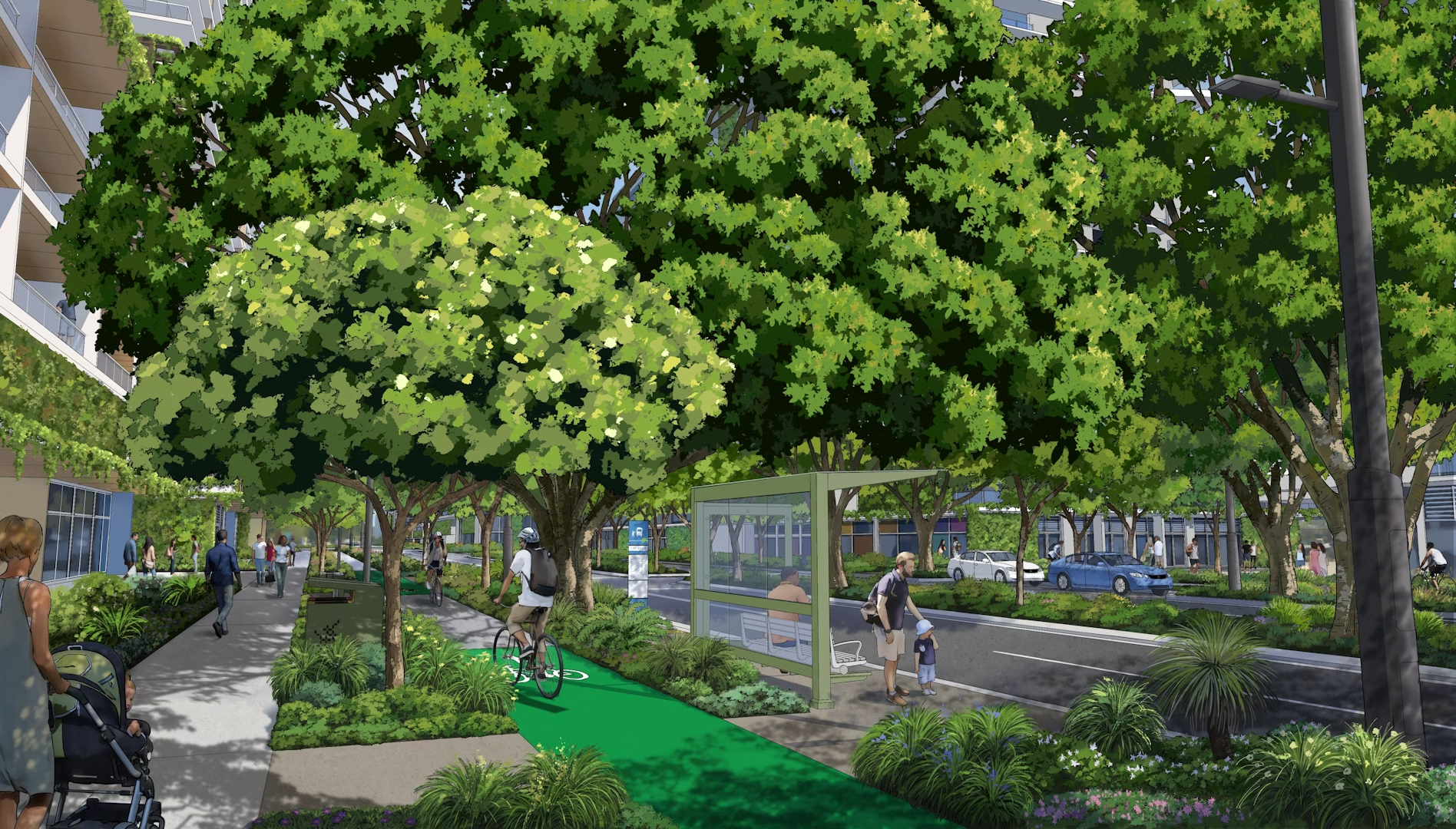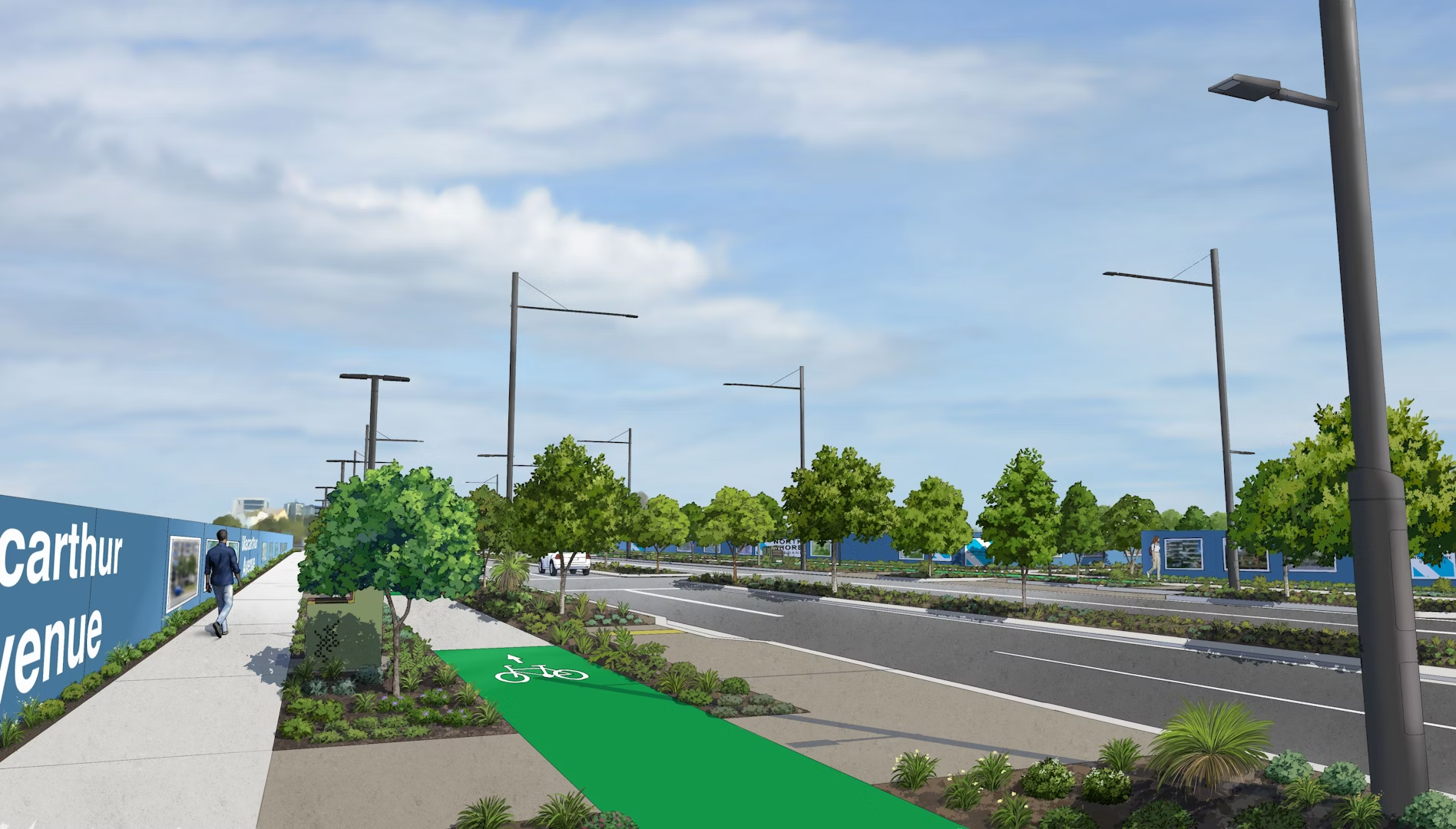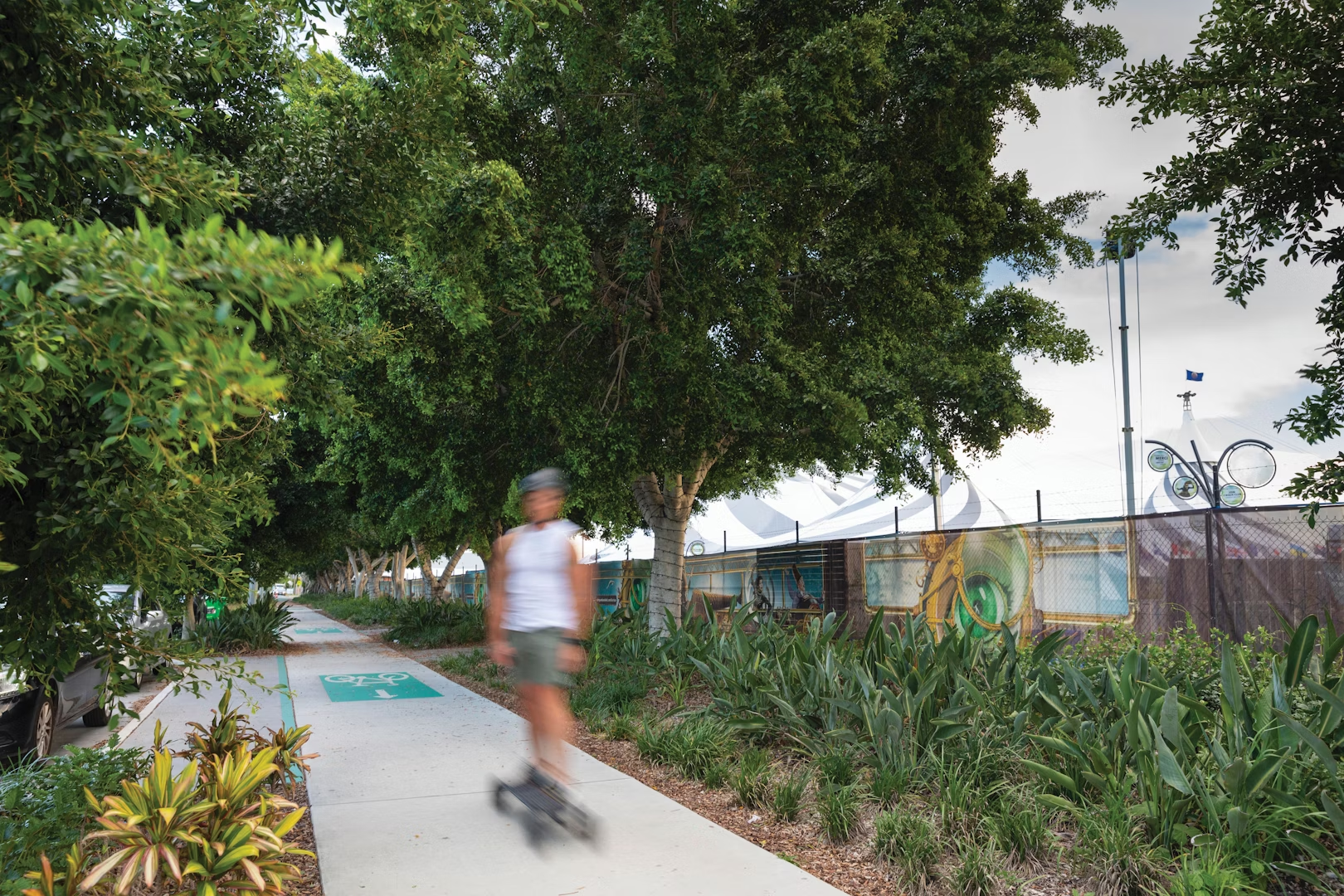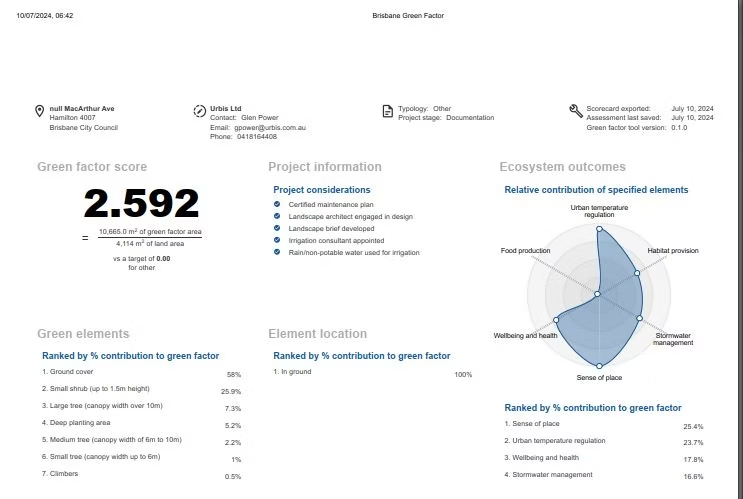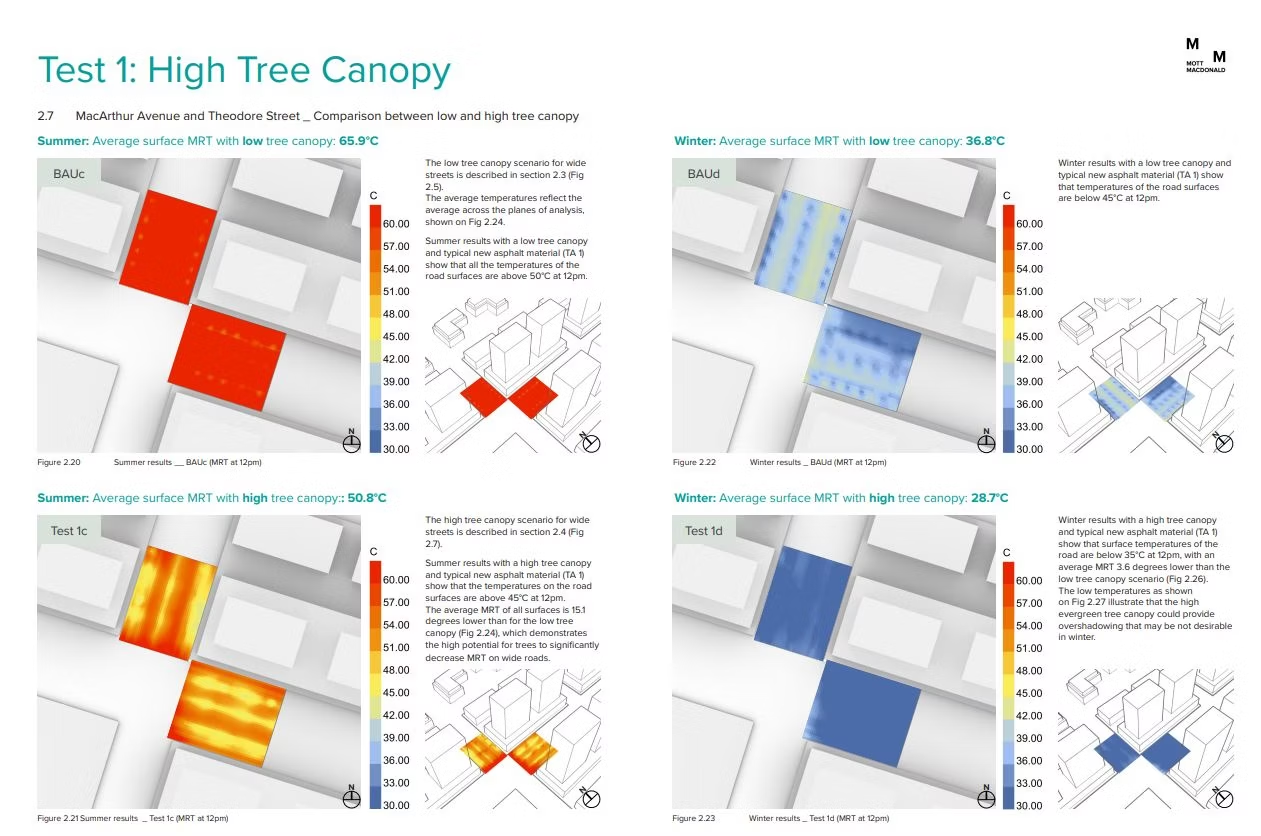Northshore Hamilton Street Renewal Program – Environmental Outcomes
Northshore Brisbane, Queensland’s largest waterfront urban renewal precinct, is designed as a model for sustainable, sub-tropical living. It will serve as the Brisbane 2032 Olympic and Paralympic athletes’ village, later transitioning into a dynamic residential, commercial, and industrial area.
Through EDQ’s Northshore Street Renewal Program, the project intends to achieve 76% shade cover on verges and 63% across the site, helping to reduce heat stress and enhance climate resilience. The project incorporates culturally significant vegetation for First Nations peoples and climate-resilient tree species, promoting a sustainable lifestyle for future residents.
The success of the project is due to an innovative digital workflow and an interdisciplinary approach, addressing challenges such as street lighting, passive irrigation, flooding, water quality and accessibility. This initiative not only creates shaded, comfortable spaces but also enhances active transport routes and supports the sharing of cultural knowledge, contributing to a more resilient future.
Describe WHAT you have done and HOW you have done it. Please provide a summary of your initiative, innovation, or approach.
Northshore Brisbane, Queensland’s largest waterfront precinct, is setting a new standard for sustainable urban design as the first project in Queensland to target an IS rating (v2.1). Led by Economic Development Queensland (EDQ), the Northshore Street Renewal Program showcases cutting-edge green infrastructure, exemplifying biophilic design, biodiversity net gain, and ecosystem improvement.
At the core of this initiative is an ambitious tree canopy target, aimed at reducing the urban heat island effect (UHIE) and optimising urban cooling for climate resilience. Key features of the program include:
• High street tree canopy cover to reduce heat stress
• Integrated stormwater and passive irrigation systems
• Collaborative First Nations design and species selection
• Universal design considerations beyond DDA compliance
The project’s success comes from a collaborative effort involving EDQ, Urbis, ADG, Mott MacDonald, and Roesner and Hamilton, ensuring sustainable streetscape outcomes through thoughtful integration of trees, lighting, and stormwater solutions.
The process involved:
- Strong Vision and Leadership by setting ambitious goals and guiding the project’s direction.
- Educating stakeholders on tree science and the benefits of urban tree planting – which led to selecting tree species not presently included in standard street tree planting local planning controls.
- Engaging First Nations representatives to incorporate culturally significant and resilient plant species.
- Analysing streetscape scenarios to optimise canopy cover and mitigate UHIE (i.e. low (≃15%), medium (≃50%), and high (≃80%), and the effects on Mean Radiant Temperature of the selected representative sites.
- Testing and refining designs through iterative urban heat assessments, focusing on maximising shading and cooling effects.
- Using innovative structural soil cells, which are not yet widely used, to support tree roots for healthier growth and a robust canopy in constrained areas, demonstrating their potential to drive wider industry adoption of Australian made green infrastructure solutions.
- Balancing street lighting with canopy goals to enhance walkability and public amenity.
The iterative design process at Northshore Brisbane utilised advanced analysis, including sunlight hours, climate data, and mean radiant temperature (MRT) assessments. By testing various canopy cover scenarios, from 15% to 80% the impact on cooling was thoroughly evaluated. This analysis identified ‘hot spots’ and developed strategies to enhance street cooling through targeted tree canopy cover, thoughtful material selection, and an optimised streetscape hierarchy.
This comprehensive approach not only tackled current difficulties in street lighting and tree selection practices that limit tree canopy outcomes to deliver significant urban cooling outcomes. It enhances liveability, boosts biodiversity, and upholds the cultural and ecological values of the area. Northshore Brisbane is a model for future developments, seamlessly integrating sustainability with community-focused design.
Through the Northshore Street Renewal Program, EDQ is creating a legacy of climate resilience, cultural inclusion, and sustainable urban living. By educating stakeholders, integrating culturally significant plants, optimising canopy cover, refining designs with heat assessments, and employing advanced structural soil cells, EDQ is setting a new standard in urban design.
What were the OUTCOMES and how were those outcomes shared?
The Northshore Brisbane project establishes a new standard in sustainable urban design with its innovative street tree initiative. Key achievements include:
• Targeted Canopy Cover: Priority streets have been identified for high tree canopy cover based on urban heat and active transport usage, enhancing the overall green infrastructure.
• Innovative Verge Designs: Wider verge designs have been delivered to accommodate extensive street tree planting.
• Optimised Infrastructure: Drainage and civil works have been refined to support mature trees with passive irrigation, water storage and water quality treatment.
• Exceptional Shade Coverage: Achieving 76% shade on verges and 63% across the site, Northshore Brisbane surpasses Brisbane City Council’s 50% shade cover target for 2031 (BCC shade target for pathway and cycle tracks only).
• Significant Urban Cooling: UHIE modelling demonstrates a 16°C reduction in surface temperature in shaded areas for 2090, mitigating outdoor heat stress and enhancing the comfort of active transport routes.
Sustainable Streetscape Outcomes:
• Environmental Benefits:
- Ecosystem Services: The canopy sequesters carbon and reduces the urban heat island effect. The integrated stormwater system reuses water for irrigation, supporting tree growth and climate resilience. According to the Brisbane City Council GreenFactor Tool, the ecosystem benefits have improved by 50% compared to other sub-tropical streets.
- Climate Resilience: The project addresses urban heat risk through ambitious canopy cover (that is suitable to future projected climate) and stormwater management, reducing energy use for cooling and managing stormwater to mitigate flooding.
• Social Benefits:
- Health and Wellbeing: Biophilic design principles enhance mental health by connecting people to nature, reducing heat stress and creating liveability.
- Active Transport: Shaded routes encourage outdoor activities, promote physical health, and reduce vehicle emissions.
- Creating Place: The high tree canopy and native species foster a distinct sense of place and visual appeal, enhancing the environment for all users.
- Designing with Country: Integrating cultural knowledge into the selection of important trees and plants, this approach enriches social inclusion and strengthens the identity of Northshore. By incorporating First Nations’ perspectives, the project enhances cultural relevance and community connection.
- Traffic Calming: Tree-lined streets naturally slow traffic, enhancing safety and reducing congestion.
Sharing the Impact:
The outcomes of this initiative have been widely shared through various channels:
• ISC Case Study: Documented as part of the ISC v2.1 rating, featured on the ISC website, and promoted through Urbis, ADG, and Mott MacDonald’s social media.
• Innovation Recognition: An ISC v2.1 innovation claim was submitted for the digital approach to UHIE assessment, with presentations given to the Australian Institute of Landscape Architecture (Queensland Charter) and other relevant forums.
• Workshops and Presentations: Engaged with key stakeholders including EDQ, the Project Design Team, Brisbane City Council, community members, Queensland Infrastructure Sustainability Community of Practice (CoP), Queensland Transport and Main Roads, and the Environmental Institute of Australia and New Zealand (EIANZ) at the Nature Positive Symposium in Sydney. Internal presentations were also made to Mott MacDonald transport engineers.
The Northshore Brisbane project has set a high standard by achieving 76% shade cover and significantly improving urban cooling, making streets more comfortable and walkable.
EDQ is actively sharing these outcomes through case studies, presentations, and workshops to encourage broader industry adoption. This approach illustrates how integrating green infrastructure with urban planning can effectively support community well-being and sustainable development.
Describe WHO benefited from your initiative, innovation, or approach?
The sustainable streetscape design at Northshore Brisbane delivers impactful benefits across various stakeholders:
• Future Community: The initiative will greatly enhance the lives of Northshore’s future residents, workers, and visitors, including those attending the Brisbane 2032 Games. The green infrastructure will support the health and well-being of an estimated 24,500 residents, 25,000 employees, and tens of thousands of annual visitors. It will create a vibrant, cohesive community space, fostering local engagement and stewardship. By incorporating Indigenous cultural knowledge, the project also strengthens cultural ties and fosters a shared sense of heritage.
• Economic Development Queensland (EDQ): Northshore Brisbane sets a new benchmark for streetscape design and tree canopy standards within EDQ’s portfolio. This project exemplifies EDQ’s commitment to sustainable development, building on a decade of achievements that include over $3.7 billion in private sector investment and $1 billion in infrastructure across 34 Priority Development Areas. The success of Northshore Brisbane will drive further innovations and improvements in urban design throughout Queensland.
• Brisbane City Council (BCC): The project challenges and redefines industry and Council standards, proving that high street tree canopy coverage is achievable and beneficial. It demonstrates how to integrate advanced lighting and stormwater management with extensive street tree planting, setting a precedent for future urban planning and design.
• Indigenous Communities: The ’Designing with Country’ initiative highlights and honours Indigenous culture by incorporating tree species of cultural significance. This approach not only respects and celebrates traditional knowledge but also contributes to reconciliation and cultural appreciation. It transforms the urban environment into a space of cultural learning and belonging, enriching the community and fostering a deeper connection to the land.
• Industry: The Northshore Brisbane project showcases innovative practices in urban design and green infrastructure, setting a new standard for the industry. By demonstrating effective integration of high canopy coverage, advanced stormwater management, and cultural considerations, it provides a practical model for other developers and urban planners. This not only drives industry-wide adoption of sustainable and resilient design principles but also encourages the development of new technologies and solutions, paving the way for more impactful and environmentally responsible urban projects.
What LEGACY and UN SDG CONTRIBUTION was achieved?
Northshore Brisbane, Queensland’s largest waterfront urban renewal precinct, is designed as a model for sustainable, sub-tropical living. It will serve as the Brisbane 2032 Olympic and Paralympic athletes’ village, later transitioning into a dynamic residential, commercial, and industrial area.
Through EDQ’s Northshore Street Renewal Program, the project intends to achieve 76% shade cover on verges and 63% across the site, helping to reduce heat stress and enhance climate resilience. The project incorporates culturally significant vegetation for First Nations peoples and climate-resilient tree species, promoting a sustainable lifestyle for future residents.
The success of the project is due to an innovative digital workflow and an interdisciplinary approach, addressing challenges such as street lighting, passive irrigation, flooding, water quality and accessibility. This initiative not only creates shaded, comfortable spaces but also enhances active transport routes and supports the sharing of cultural knowledge, contributing to a more resilient future.
The sustainable streetscape design at Northshore Hamilton is set to deliver a lasting legacy through the following impactful achievements:
• New Standards in Sustainable Urban Development: Northshore Brisbane redefines urban design with its ambitious tree canopy cover goals, innovative approaches to street lighting, and integrated stormwater management. This sets a new benchmark for creating pedestrian and cycle-friendly environments that promote active transport and high-quality urban living.
- SDG 11: Sustainable Cities and Communities: By improving urban infrastructure to be more sustainable and walkable.
- SDG 13: Climate Action: Through significant contributions to urban cooling and environmental resilience.
• Healthy and Robust Landscape: The project’s commitment to a high canopy target and cutting-edge stormwater management fosters a resilient and thriving landscape. This robust environment enhances biodiversity, reduces maintenance needs, and offers vital ecosystem services like air purification and temperature regulation, ultimately enriching the quality of life for residents and visitors. - SDG 11: Sustainable Cities and Communities: By enhancing the urban environment and supporting biodiversity.
- SDG 13: Good Health and Well-being: Through improved environmental quality and ecosystem resilience.
• Development of Innovative UHIE Assessment Methodology: The project has pioneered a new digital workflow for urban heat island effect (UHIE) assessment, enabling precise and interactive design optimisation. This approach integrates seamlessly with civil design and other requirements, setting a new industry standard and influencing practices in urban cooling and design. - SDG 9: Industry, Innovation, and Infrastructure: By advancing methodologies and tools for urban design.
- SDG 11: Sustainable Cities and Communities: Through improved urban planning and infrastructure.
- SDG 13: Climate Action: By addressing climate impacts with innovative solutions.
• First Nations Outcomes: Through the ’Designing with Country’ initiative, the project honours Indigenous culture and strengthens community ties. By incorporating culturally significant plants and respecting traditional knowledge, Northshore Brisbane fosters a deep sense of belonging and cultural appreciation, contributing to reconciliation and social inclusion. - SDG 10: Reduced Inequalities: By promoting cultural recognition and inclusion.
- SDG 11: Sustainable Cities and Communities: By integrating Indigenous perspectives into urban design.
- SDG 13: Good Health and Well-being: By enhancing community well-being through cultural and environmental integration.
Northshore Brisbane’s legacy extends beyond its immediate outcomes, setting new industry standards, promoting resilience, and showcasing how thoughtful urban design can align with global sustainability goals. Through these advancements, this project paves the way for future developments that balance infrastructure needs with environmental stewardship and community well-being.


